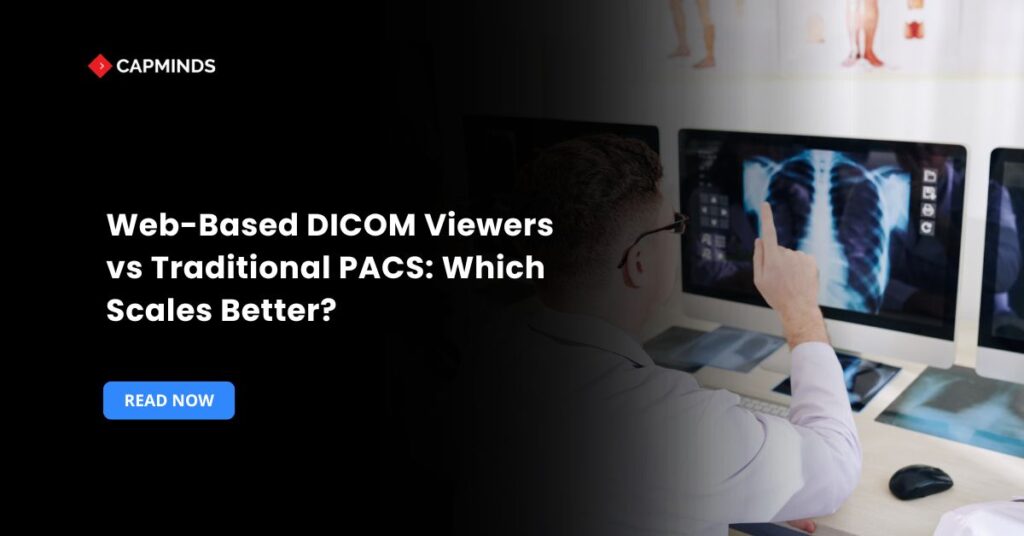Web-Based DICOM Viewers vs Traditional PACS: Which Scales Better?
Healthcare practices face demand on medical imaging operations to become more scalable, adaptable, and efficient. For the storage, retrieval, and viewing of DICOM, two main software programs have been developed. Modern web-based DICOM viewers and traditional on-premises PACS.
Although both strategies make diagnostic imaging easier, they differ greatly in terms of architecture, deployment, upkeep, and most importantly, scalability. In this blog, you’ll learn the best solutions that assist healthcare IT providers in finding the best imaging software.
Traditional PACS vs Web-Based DICOM
Traditional PACS
A traditional PACS is an on-premises system that includes dedicated servers for storing DICOM images, a network of modality interfaces, and desktop viewer programs.
- Centralized server infrastructure is typically located in a hospital’s data center or server room.
- Radiologists and clinicians install thick-client apps on their local desktops.
- Rigid network topology requires dedicated LAN bandwidth and VPNs for distant access.
Web-Based DICOM Viewers
Web-based DICOM viewers use modern web technologies to stream and display DICOM images in regular browsers.
- Cloud-based or hybrid deployment can operate entirely in the cloud, on-premises, or in a hybrid configuration.
- Zero-footprint clients require no installation, only an HTML5-compatible browser.
- The underlying servers and containers can auto-scale in response to demand.
Scalability Considerations
1. Infrastructure Flexibility
Traditional PACS has a fixed capacity of storage and requires additional physical servers or SAN storage. Hardware acquisitions and rack installation can take weeks to months.
Web-Based viewers have storage on cloud platforms such as AWS, Azure, which enables on-demand VMs or Kubernetes clusters.
2. Performance Under Load
Traditional PACS peak-hour usage can affect the hospital LAN, which leads to slow image retrieval. Local PACS caching strategies may not suffice during concurrent multi-site access.
In web-based DICOM viewers, images can be cached at edge locations to accelerate delivery for geographically dispersed users. Progressive JPEG2000 or WebGL-based rendering reduces bandwidth and CPU usage on the client side.
3. Maintenance and Upgrades
Traditional imaging software requires manual updates, and IT staff must schedule downtime for patching servers and desktop clients. Different departments run on different software versions, which complicates support.
Web-based Viewers updates are instantly available to all users without local installation. Individual components can be updated independently, minimizing downtime.
Cost Implications Over Time
|
Cost Factor |
Traditional PACS |
Web-Based DICOM Viewer |
| Upfront CapEx |
High on servers, SAN, licenses |
Moderate on cloud setup, SaaS |
| Ongoing OpEx |
Lower if underutilized, spikes with hardware refresh cycles. |
Pay-as-you-use |
| Maintenance Staff |
Dedicated in-house team |
Vendor-managed or lean DevOps team |
| Scaling Costs |
Big purchases |
Granular Scaling |
Traditional PACS sometimes require major financial investments every 3-5 years for hardware upgrades, as well as ongoing software maintenance expenditures.
Web-Based DICOM Viewers turn a large portion of this into operational expenditures, which might vary but typically give more predictable unit costs per user or research.
Related: Transforming Radiology with Seamless Integration of OpenEMR and DICOM
Accessibility and Collaboration
Traditional PACS
- On-site focus is best suited for a single campus or a network of hospitals. VPNs or specialized terminals are typically required for remote access.
- Limited multi-site collaboration allows sharing photos across universities, frequently requiring disk shipments or secure file transfers.
Web-Based Viewers
- Providers may view studies via browser on computers, tablets, and even mobile phones, allowing for teleradiology and on-call consultations.
- Many systems provide real-time annotations, chat, and screen-sharing right in the viewer.
Security and Compliance
Traditional PACS provides complete control over on-premises data storage. It relies on VPNs and firewall regulations. Legacy PACS varies by vendor and can have frequently segregated logs. It requires separate off-site DR gear.
The web-based viewer is configurable in regional cloud zones. It uses modern IAM frameworks such as OAuth2, SAML, and MFA. Web-based DICOM viewer is centralized, with real-time monitoring and notifications. It is integrated with multi-AZ cloud redundancy.
Both approaches can meet the HIPAA and GDPR.
Web-based viewers frequently provide advanced, out-of-the-box compliance capabilities. Organisations must assess providers and build environments to secure data sovereignty and robust encryption controls.
Real-World Scaling Scenarios
A Small Clinic Network Expands to Telehealth
Traditional PACS may struggle when clinics add remote physicians, where VPN licensing and VPN throughput become barriers.
Web-Based Viewer instantly enables new user accounts and requires no local software installations, allowing for fast telemedicine implementation.
Large Hospital System Adds New Modalities
To manage rising storage volumes, legacy PACS requires extra servers, rack space, power, and cooling.
Web-Based Viewer simply adds additional imaging modalities to the cloud pipeline, while auto-scaling storage tiers handle data expansion.
Disaster Recovery and Business Continuity
Traditional PACS disaster recovery frequently entails keeping duplicate hardware off-site.
Web-based uses multi-region cloud replication, and failover can occur automatically in minutes.
Drawbacks and Considerations
- Web-based viewers require steady internet connections; in low-bandwidth contexts, performance may suffer unless offline caching solutions are adopted.
- Cloud egress costs may apply when accessing large amounts of photos from storage.
- Migrating between cloud providers or returning to on-premises might be complicated.
- Custom interfaces or gateways may be required to connect existing modalities and reporting systems to web-based platforms.
Conclusion
A web-based DICOM viewer provides improved flexibility and lower time-to-value for enterprises expecting considerable development, whether via the addition of new imaging modalities, the expansion of telehealth solutions, or the scaling of multi-site operations.
Smaller facilities with restricted resources and consistent, predictable workloads may find that a legacy PACS is less expensive overall if hardware refresh cycles are adequately scheduled.
Hybrid systems are becoming increasingly popular, combining on-premises storage with web-based viewing layers allows for data residency control while also providing elastic access and maintenance benefits.
Related: The Comprehensive Features of DICOM Viewer Healthcare Practices Should Know
DICOM Viewer Customization Service by CapMinds
Want to get the most from the DICOM Viewer from your EMR systems? CapMinds is here to help you.
We are a professional health tech company with years of experience in EHR, EMR, OpenEMR, HL7 FHIR, Mirth Connect, Health Interoperability, and More. Our DICOM customization service includes:
- Custom Layouts and Toolbars
- Advanced Image Processing Capabilities
- Comprehensive Data Visualization
Our team of experts will closely work with you to tailor every aspect of the DICOM viewer in your EMR system, ensuring a smooth workflow.
Elevate your diagnostic capabilities and streamline your radiology practice with a DICOM viewer that truly puts you in control.
Contact CapMinds today and experience the full potential of the DICOM viewer for your Practice.



